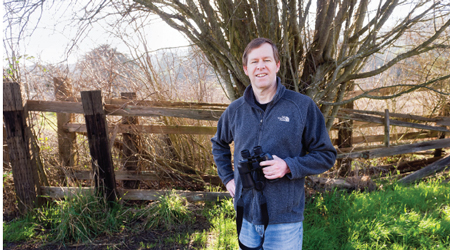At Brooklyn’s Coney Island, there’s a contest to see who can eat the most hot dogs in the least time. In Gloucestershire, England, there’s cheese-rolling, and in Finland, there’s wife-carrying over an obstacle course. In our Bay Area, there’s a contest to see who can find the largest number of endangered species and help them survive.
Our contest takes place in even-numbered years in the Golden Gate National Recreation Area, home to more endangered animals and plants than any other national park in North America. Thirty-six species of mammals, reptiles, amphibians, birds, invertebrates, fish and plants that live within GGNRA’s borders are threatened with extinction. The 75,000-acre park, which stretches from Tomales Bay in the north to Woodside in the south, includes such attractions as Alcatraz, Muir Woods and Point Reyes National Seashore in Marin, Ocean Beach in San Francisco, and Mori Point in Pacifica.
When Brent Plater heard about GGNRA’s dubious distinction, he decided to do something about it. A 36-year-old attorney who lives in San Francisco and teaches environmental law at San Francisco State, Plater directs the Wild Equity Institute (WEI). He had a brainstorm: aware that birding groups hold competitions to see who can find and identify the most bird species, he borrowed that format but tacked on an additional element—remediation. Naming the contest Endangered Species Big Year, Plater obtained the cooperation and support of GGNRA officials. More than 200 contestants signed up for Big Year 2010 through the organization’s website, wildequity.org, which provided information, ideas and instructions. Whoever found the largest number of the 36 endangered species and completed the largest number of specified conservation tasks in the yearlong competition would win $1,000. If you saw the humpback whale, for example, your task was to ask public officials to impose speed limits in marine sanctuaries so that fewer whales would be struck by ships. For the coho salmon, contestants helped park personnel net fish trapped in drying pools and transfer them to flowing streams. “I actually rescued salmon who were going to die!” one enthusiastic participant exclaimed.
Contestants went out at night to find northern spotted owls and submerged wearing wetsuits in Lagunitas Creek to find California freshwater shrimp. Finding the western snowy plover, a sparrow-size shorebird, was not so difficult, since it lives near Ocean Beach and Crissy Field, areas that attract hikers and dog-walkers, but the associated task could be daunting. According to park officials, unleashed dogs threaten these little birds because of the havoc created when the dogs chase them.
To help the species, Big Year contestants were instructed to approach dog owners whose pets were running free, explain about the plover and ask them to leash the dog. While some owners were willing to comply, others reacted angrily and stalked away, says Matt Zlatunich, a San Francisco firefighter and Big Year volunteer who has been especially active in patrolling the beaches.
One contestant and his family commuted all the way from Union City to take part in Big Year. Matthew Latimer explains that on the way to finding the San Mateo sunflower in the Crystal Springs watershed, “the leaders had special permits for us to go in parts of the park that are usually off limits, and along the way this expert was pointing out different butterflies, what they are doing, how they are patrolling the path we’re on. With Big Year, you get a lot more out of the park experience, and you meet these great people.”
Contestants also encountered storied creatures like the California red-legged frog, which lives near Mori Point in Pacifica, the northern spotted owl, which lives in Muir Woods, and the tiny salt marsh harvest mouse, which hides in pickleweed near the seashore and weighs about as much as a nickel. Some endangered plants, like the Presidio manzanita and the showy Indian clover, are so rare and fragile that they were not eligible to be searched for.
This year’s contest ended in a dead heat between San Francisco butterfly expert Liam O’Brien and San Rafael brand consultant Steve Price. Both spotted 18 of the species and completed all 36 related actions. “You gain an awareness of the enormous diversity of species in GGNRA alone,” says Price. “And the need to protect them.”
The WEI website has a page for each species explaining where to find it, describing its life cycle and listing opportunities to help out. Anyone, not just Big Year contestants, can go exploring to find these threatened plants and animals and is welcome to take part in a wide assortment of volunteer activities aimed at safeguarding their habitats.
Perhaps in response to Big Year, park officials recently decided to highlight one species each year for special attention. For 2011, it’s the Mission blue butterfly, which can be found in Marin’s Fort Baker and on Milagra Ridge in San Mateo. The size of a quarter, the Mission blue only lives for six to 10 days between late March and mid-June. As winter rains turn to April showers and May flowers, you might want to take a hike to find one of these butterflies perching on a lupine and feasting on its leaves. Visit wildequity.org/species/26 to learn more; you may be surprised at the oddities of the Mission blue’s life cycle, and you’ll learn what you can do to help this tiny, exquisite creature.


